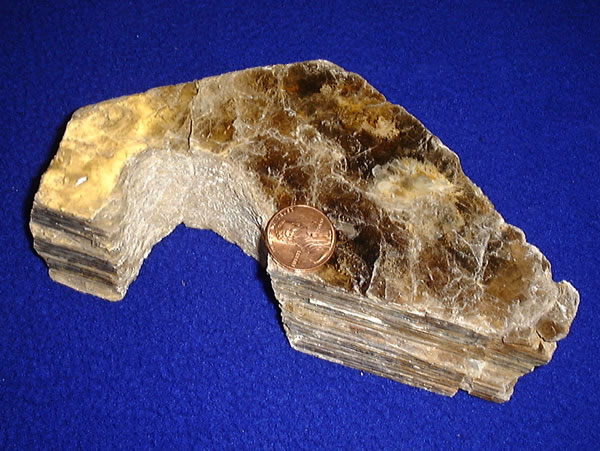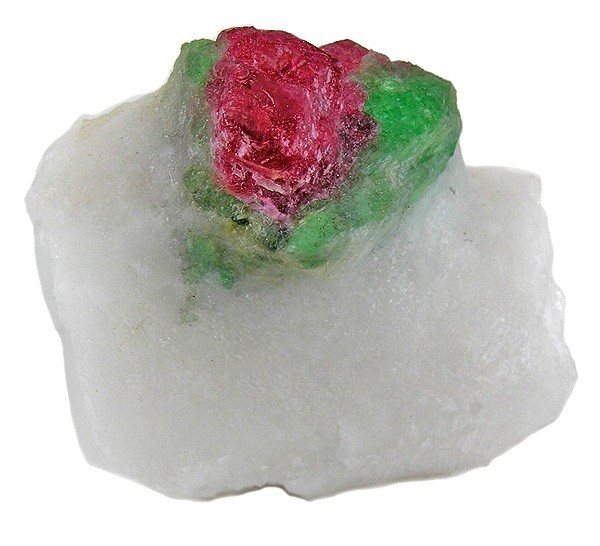|
Phlogopite
Phlogopite is a yellow, greenish, or reddish-brown member of the mica family of phyllosilicates. It is also known as magnesium mica. Phlogopite is the magnesium endmember of the biotite solid solution series, with the chemical formula KMg3AlSi3O10(F,OH)2. Iron substitutes for magnesium in variable amounts leading to the more common biotite with higher iron content. For physical and optical identification, it has most of the characteristic properties of biotite. Paragenesis Phlogopite is an important and relatively common end-member composition of biotite. Phlogopite micas are found primarily in igneous rocks, although it is also common in contact metamorphic aureoles of intrusive igneous rocks with magnesian country rocks and in marble formed from impure dolomite (dolomite with some siliclastic sediment). The occurrence of phlogopite mica within igneous rocks is difficult to constrain precisely because the primary control is rock composition as expected, but phlogopite is ... [...More Info...] [...Related Items...] OR: [Wikipedia] [Google] [Baidu] |
Phlogopite Peridotite
Phlogopite is a yellow, greenish, or reddish-brown member of the mica family of phyllosilicates. It is also known as magnesium mica. Phlogopite is the magnesium endmember of the biotite solid solution series, with the chemical formula KMg3AlSi3O10(F,OH)2. Iron substitutes for magnesium in variable amounts leading to the more common biotite with higher iron content. For physical and optical identification, it has most of the characteristic properties of biotite. Paragenesis Phlogopite is an important and relatively common end-member composition of biotite. Phlogopite micas are found primarily in igneous rocks, although it is also common in contact metamorphic aureoles of intrusive igneous rocks with magnesian country rocks and in marble formed from impure dolomite (dolomite with some siliclastic sediment). The occurrence of phlogopite mica within igneous rocks is difficult to constrain precisely because the primary control is rock composition as expected, but phlogopite is als ... [...More Info...] [...Related Items...] OR: [Wikipedia] [Google] [Baidu] |
Mica
Micas ( ) are a group of silicate minerals whose outstanding physical characteristic is that individual mica crystals can easily be split into fragile elastic plates. This characteristic is described as ''perfect basal cleavage''. Mica is common in igneous and metamorphic rock and is occasionally found as small flakes in sedimentary rock. It is particularly prominent in many granites, pegmatites, and schists, and "books" (large individual crystals) of mica several feet across have been found in some pegmatites. Micas are used in products such as drywalls, paints, and fillers, especially in parts for automobiles, roofing, and in electronics. The mineral is used in cosmetics and food to add "shimmer" or "frost". Properties and structure The mica group comprises 37 phyllosilicate minerals. All crystallize in the monoclinic system, with a tendency towards pseudohexagonal crystals, and are similar in structure but vary in chemical composition. Micas are translucent to opa ... [...More Info...] [...Related Items...] OR: [Wikipedia] [Google] [Baidu] |
Phyllosilicate
Silicate minerals are rock-forming minerals made up of silicate groups. They are the largest and most important class of minerals and make up approximately 90 percent of Earth's crust. In mineralogy, the crystalline forms of silica (silicon dioxide, ) are usually considered to be Silicate mineral#Tectosilicates, tectosilicates, and they are classified as such in the Dana system (75.1). However, the Nickel-Strunz system classifies them as oxide minerals (4.DA). Silica is found in nature as the mineral quartz, and its polymorphism (materials science), polymorphs. On Earth, a wide variety of silicate minerals occur in an even wider range of combinations as a result of the processes that have been forming and re-working the crust for billions of years. These processes include partial melting, crystallization, fractionation, metamorphism, weathering, and diagenesis. Living organisms also contribute to this carbonate–silicate cycle, geologic cycle. For example, a type of plankton ... [...More Info...] [...Related Items...] OR: [Wikipedia] [Google] [Baidu] |
Ultrapotassic Igneous Rocks
Ultrapotassic igneous rocks are a class of rare, volumetrically minor, generally ultramafic or mafic silica-depleted igneous rocks. While there are debates on the exact classifications of ultrapotassic rocks, they are defined by using the chemical screens K2O/Na2O > 3 in much of the scientific literature. However caution is indicated in interpreting the use of the term "ultrapotassic", and the nomenclature of these rocks continues to be debated, with some classifications using K2O/Na2O > 2 to indicate a rock is ultrapotassic. Conditions of formation The magmas that produce ultrapotassic rocks are produced by a variety of mechanisms and from a variety of sources, but generally occur in a heterogenous, anomalous, phlogopite-bearing upper mantle. The following conditions are favorable for the formation of ultrapotassic magmas. * partial melting at a great depth * low degrees of partial melting * lithophile element ( K, Ba, Cs, Rb) enrichment in sources * enriched peridot ... [...More Info...] [...Related Items...] OR: [Wikipedia] [Google] [Baidu] |
Lamproite
Lamproite is an ultrapotassic mantle-derived volcanic or subvolcanic rock. It has low CaO, Al2O3, Na2O, high K2O/Al2O3, a relatively high MgO content and extreme enrichment in incompatible elements. Lamproites are geographically widespread yet are volumetrically insignificant. Unlike kimberlites, which are found exclusively in Archaean cratons, lamproites are found in terrains of varying age, ranging from Archaean in Western Australia, to Palaeozoic and Mesozoic in southern Spain. They also vary widely in age, from Proterozoic to Pleistocene, the youngest known example from Gaussberg in Antarctica being 56,000 ± 5,000 years old. Lamproite volcanology is varied, with both diatreme styles and cinder cone or cone edifices known. Petrology Lamproites form from partially melted mantle at depths exceeding 150 km. The molten material is forced to the surface in volcanic pipes, bringing with it xenoliths and diamonds from the harzburgitic peridotite or eclogite ... [...More Info...] [...Related Items...] OR: [Wikipedia] [Google] [Baidu] |
Picrite Basalt
Picrite basalt or picrobasalt is a variety of high-magnesium olivine basalt that is very rich in the mineral olivine. It is dark with yellow-green olivine phenocrysts (20-50%) and black to dark brown pyroxene, mostly augite. The olivine-rich picrite basalts that occur with the more common tholeiitic basalts of Kīlauea and other volcanoes of the Hawaiian Islands are the result of accumulation of olivine crystals either in a portion of the magma chamber or in a caldera lava lake. The compositions of these rocks are well represented by mixes of olivine and more typical tholeiitic basalt. The name "picrite" can also be applied to an olivine-rich alkali basalt: such picrite consists largely of phenocrysts of olivine and titanium-rich augite pyroxene with minor plagioclase set in a groundmass of augite and more sodic plagioclase and perhaps analcite and biotite. More generally the classification of fine grained rocks recognises a group known as 'picritic rocks' that are char ... [...More Info...] [...Related Items...] OR: [Wikipedia] [Google] [Baidu] |
Phenocryst
image:montblanc granite phenocrysts.JPG, 300px, Granites often have large feldspar, feldspathic phenocrysts. This granite, from the Switzerland, Swiss side of the Mont Blanc massif, has large white phenocrysts of plagioclase (that have trapezoid shapes when cut through). 1 euro coin (diameter 2.3 cm) for scale. A phenocryst is an early forming, relatively large and usually conspicuous crystal distinctly larger than the grains of the rock Matrix (geology), groundmass of an igneous rock. Such rocks that have a distinct difference in the size of the crystals are called Porphyry (geology), porphyries, and the adjective porphyritic is used to describe them. Phenocrysts often have euhedral forms, either due to early growth within a magma, or by post-emplacement recrystallization (geology), recrystallization. Normally the term ''phenocryst'' is not used unless the crystals are directly observable, which is sometimes stated as greater than in diameter. Phenocrysts below this level, but s ... [...More Info...] [...Related Items...] OR: [Wikipedia] [Google] [Baidu] |
Lamprophyre
Lamprophyres () are uncommon, small-volume ultrapotassic igneous rocks primarily occurring as dikes, lopoliths, laccoliths, stocks, and small intrusions. They are alkaline silica- undersaturated mafic or ultramafic rocks with high magnesium oxide, >3% potassium oxide, high sodium oxide, and high nickel and chromium. Lamprophyres occur throughout all geologic eras. Archaean examples are commonly associated with lode gold deposits. Cenozoic examples include magnesian rocks in Mexico and South America, and young ultramafic lamprophyres from Gympie in Australia with 18.5% MgO at ~250 Ma. Petrology Modern science treats lamprophyres as a catch-all term for ultrapotassic mafic igneous rocks which have primary mineralogy consisting of amphibole or biotite, and with feldspar in the groundmass. Lamprophyres are not amenable to classification according to modal proportions, such as the system QAPF, because of their peculiar mineralogy, nor compositional discrimination diagrams, ... [...More Info...] [...Related Items...] OR: [Wikipedia] [Google] [Baidu] |
Kimberlite
Kimberlite is an igneous rock and a rare variant of peridotite. It is most commonly known as the main host matrix for diamonds. It is named after the town of Kimberley, Northern Cape, Kimberley in South Africa, where the discovery of an 83.5-Carat (mass), carat (16.70 g) diamond called the Star of South Africa (diamond), Star of South Africa in 1869 spawned a diamond rush and led to the excavation of the open-pit mine called the Big Hole. Previously, the term kimberlite has been applied to olivine lamproites as Kimberlite II, however this has been in error. Kimberlite occurs in the Earth's Crust (geology), crust in vertical structures known as Volcanic pipe, kimberlite pipes, as well as igneous Dike (geology), dykes and can also occur as horizontal Sill (geology), sills. Kimberlite pipes are the most important source of mined diamonds today. The consensus on kimberlites is that they are formed deep within Earth's mantle. Formation occurs at depths between 150 and 450 kilometres ( ... [...More Info...] [...Related Items...] OR: [Wikipedia] [Google] [Baidu] |
Olivine
The mineral olivine () is a magnesium iron Silicate minerals, silicate with the chemical formula . It is a type of Nesosilicates, nesosilicate or orthosilicate. The primary component of the Earth's upper mantle (Earth), upper mantle, it is a common mineral in Earth's subsurface, but weathers quickly on the surface. Olivine has many uses, such as the gemstone peridot (or chrysolite), as well as industrial applications like metalworking processes. The ratio of magnesium to iron varies between the two endmember (mineralogy), endmembers of the solid solution series: forsterite (Mg-endmember: ) and fayalite (Fe-endmember: ). Compositions of olivine are commonly expressed as Mole (unit), molar percentages of forsterite (Fo) and/or fayalite (Fa) (''e.g.'', Fo70Fa30, or just Fo70 with Fa30 implied). Forsterite's melting temperature is unusually high at atmospheric pressure, almost , while fayalite's is much lower – about . Melting temperature varies smoothly between the two end ... [...More Info...] [...Related Items...] OR: [Wikipedia] [Google] [Baidu] |
Pargasite
Pargasite or ''pargasitic hornblende'' is a complex Silicate mineral, inosilicate mineral of the amphibole group with formula NaCa2(Mg4Al)(Si6Al2)O22(OH)2. It was first described for an occurrence in Pargas, Finland in 1814 and named for the locality. It occurs in high temperature regional metamorphic rocks and in the skarns within contact metamorphism, contact aureoles around igneous intrusions. It also occurs in andesite volcanic rocks and altered ultramafic rocks. Pargasite is the main water-storage site in the uppermost Mantle (geology), mantle; however, it becomes unstable at depths greater than . This has significant consequences for the water storage capacity, and the solidus temperature of the lherzolite of the upper mantle (Earth), upper mantle. It is used as a gemstone. See also *Anyolite References [...More Info...] [...Related Items...] OR: [Wikipedia] [Google] [Baidu] |







